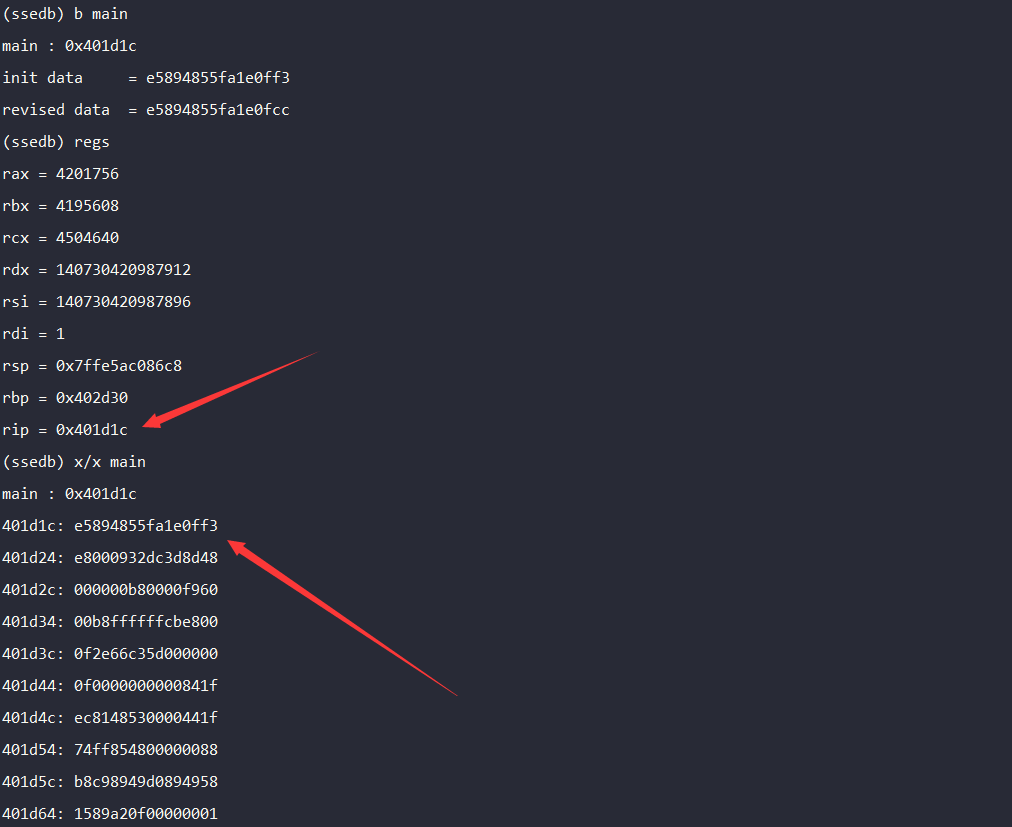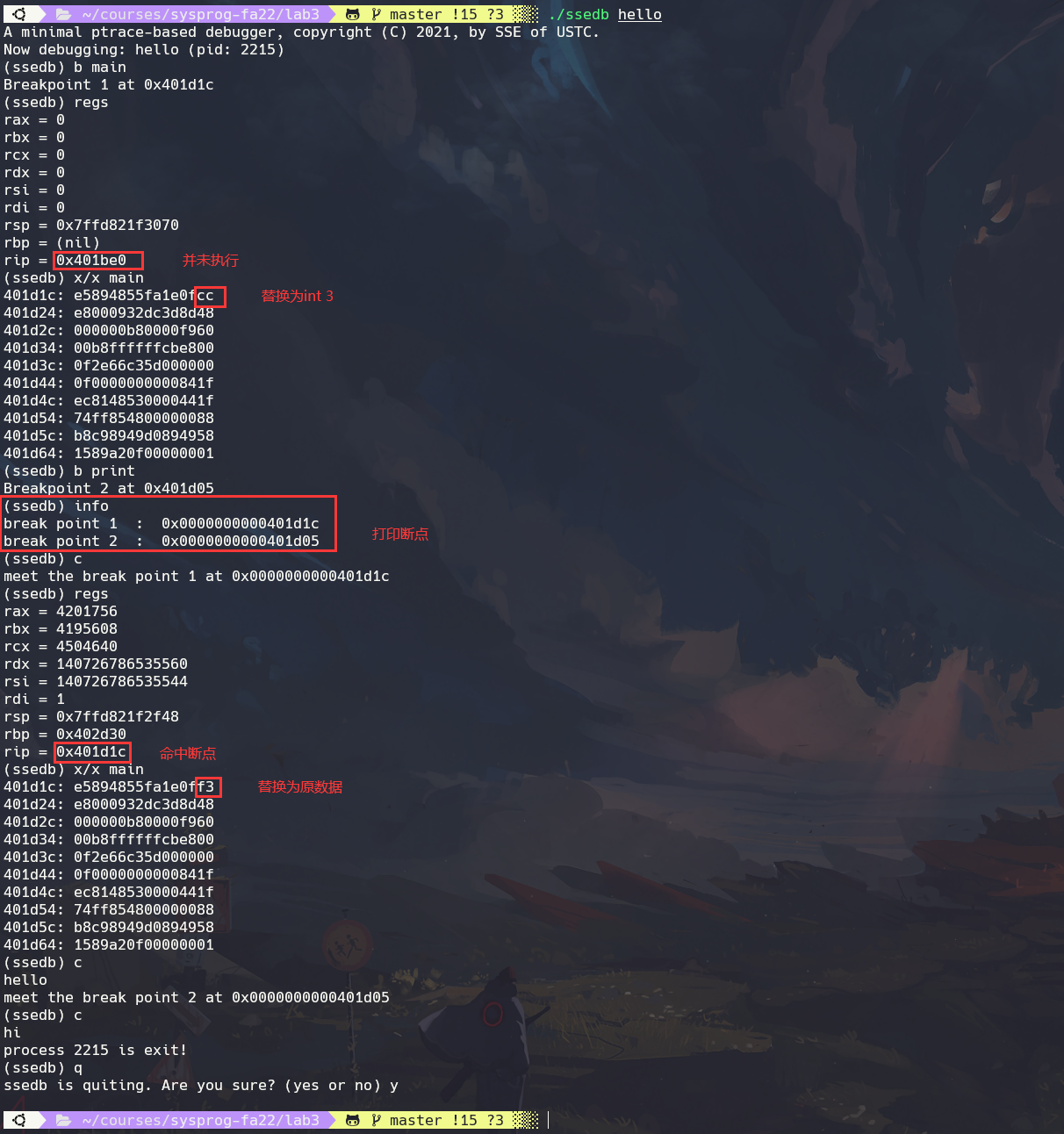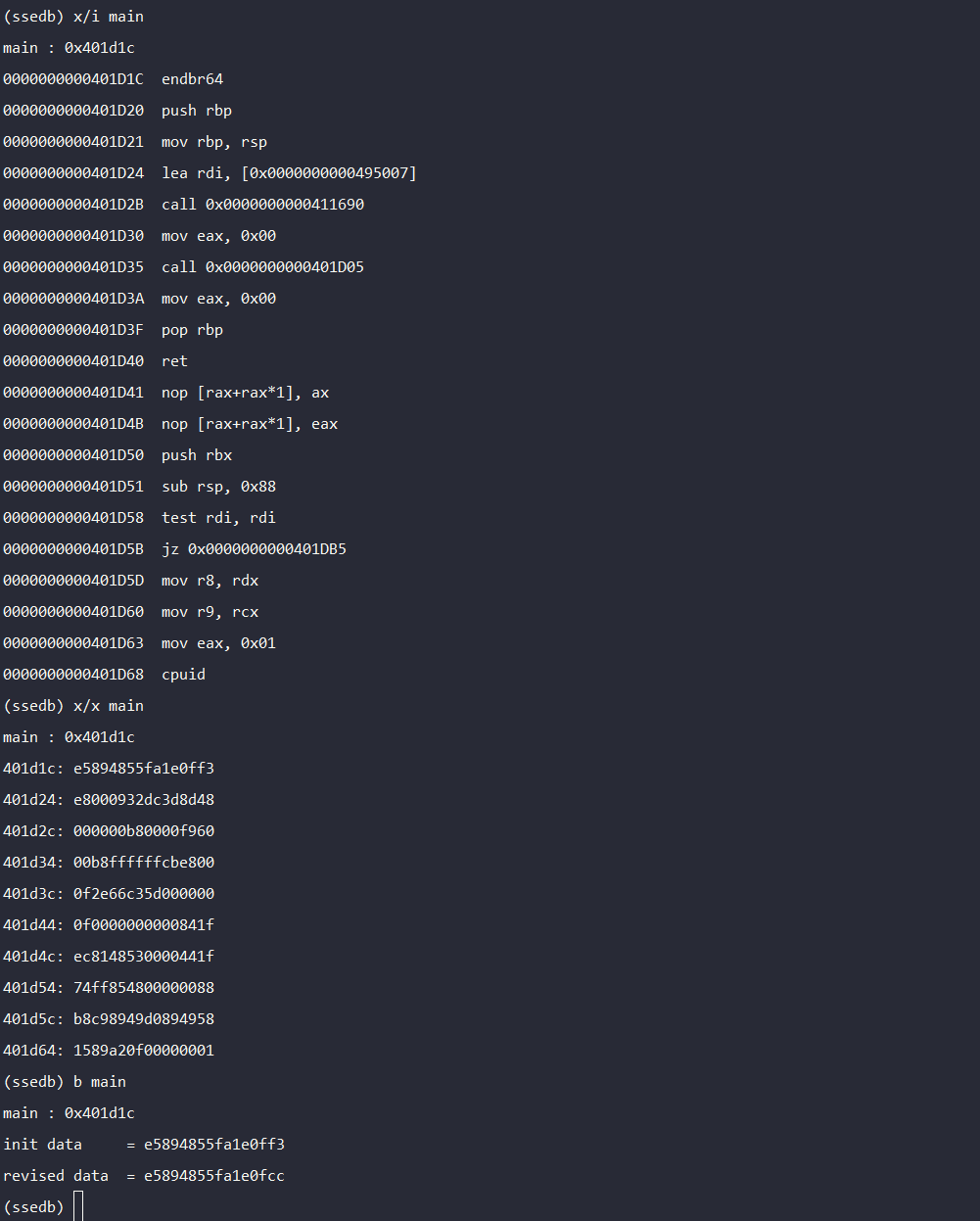lab3 :A Minimal Debugger
Exercise 1:
Now read the source file and answer the following questions.
- How the
regscommand is implemented?
Solution
定义
user_regs_struct类型变量regs接收寄存器组调用
ptrace (PTRACE_GETREGS, c->pid, 0, ®s)将寄存器的值写入regs打印各寄存器的值
Exercise 2:
Now, how the breaking point command b 0xaddr is
implemented? In fact, there is a serious bug in current implementation
we offered you. Let's check where is this bug. First run this
objdump -d helloand figure out the address of the function print,
suppose that address is 0xaddr on your machine. Now in the
ssedb, you set up a break point on address
0xaddr by typing (remember this address must be in
hexadecimal, which has a leading 0x):
(ssedb) b 0xaddrnow peek the registers:
(ssedb) regsWhat's the value of rip? Is this value right? Why?
And then disassembly the content at address 0xaddr.
(ssedb) x/x 0xaddrWhat's there? Have you detected the bug? How to fix this bug?
Solution
rip的值需要从两方面讨论,因为rip存储的是下一条指令的地址,设置断点时,将第一个字节设置为0xcc即int 3软中断指令,当子进程执行到此处时,会停止且发送信号给父进程,由于已经执行了int 3那么其实rip的值是正确的,因为它确实指向了int 3的下一条指令的地址,但是,这种情况却不是我们想要的,因为我们为了让子进程停在断点处,于是覆盖了第一个字节,那么第一个字节的指令并未执行,所以在父进程中我们就需要恢复断点信息(因为第一个字节的指令并未执行),即rip = rip - 1- 将
0xcc改为原来的值
case CMD_KIND_BREAK:{ unsigned long brk = 0x00000000000000cc; unsigned long data; unsigned long back; // copy the origin data data = ptrace(PTRACE_PEEKDATA, c->pid, c->u.addr, 0); back = data; printf ("init data = %lx\n", data); data = (data & 0xffffffffffffff00) | brk; printf ("revised data = %lx\n", data); ptrace(PTRACE_POKEDATA, c->pid, c->u.addr, data); // child will stop in (int 3) ptrace(PTRACE_CONT, c->pid, 0, 0); waitChild (); // write back the origin rip struct user_regs_struct regs; ptrace (PTRACE_GETREGS, c->pid, 0, ®s); regs.rip--; ptrace (PTRACE_SETREGS, c->pid, 0, ®s); // write back the origin data ptrace(PTRACE_POKEDATA, c->pid, c->u.addr, back); return; }没有显示前导0,只需在打印时指定正确的格式即可,即
printf ("%lx: %016lx\n", addr, data)
可以看到最低字节又修改为原来的值了
improvement
由于所给代码在b addr后会接着执行一条ptrace(PTRACE_CONT, c->pid, 0, 0);,这会导致traced程序直接命中断点,故将CONT指令移除,只设置断点,即写入一条int 3指令,并将原数据保存起来,定义struct breakpoint
struct breakpoint{
long addr;
unsigned long origin;
};存放其地址和原始数据,而真正命中断点后还原断点信息的代码放在case CMD_KIND_CONT
case CMD_KIND_CONT:{
ptrace(PTRACE_CONT, c->pid, 0, 0);
int status;
wait (&status);
// back to origin rip
struct user_regs_struct regs;
ptrace (PTRACE_GETREGS, c->pid, 0, ®s);
unsigned long long rip = regs.rip - 1;
unsigned long data = ptrace(PTRACE_PEEKDATA, c->pid, rip, 0);
if((uint8_t)data == 0xcc) { // meet break point
regs.rip--;
ptrace(PTRACE_SETREGS, c->pid, 0, ®s);
// write back the origin data
unsigned long origin = get_origin();
ptrace(PTRACE_POKEDATA, c->pid, rip, origin);
printf("meet the break point %d at 0x%016x\n", idx, rip);
}
if(WIFEXITED(status)) // exit ?
printf("process %d is exit!\n", c->pid);
return;
}这样做的结果是,b addr只设置断点,不会让traced程序继续运行,而c可以traced程序运行,并且可以命中断点,由于已经有了断点信息,索性增加了一个新的指令info:打印所有break point,实现如下:
int len = 0; // 断点个数
int idx = 0; // 命中个数
struct breakpoint bp[100];
void update_breakpoint_table(char *name, long addr, unsigned long origin){
bp[len].name = name;
bp[len].addr = addr;
bp[len].origin = origin;
len++;
}在execCommand中新增case
case CMD_KIND_INFO:{
for(int i = 0; i < len; i++)
printf("break point %d : 0x%016x\n", i + 1, bp[i].addr);
return ;
}最终执行的效果:

Exercise 3:
There is also a command to disassembly bianry into assembly intructions, but has not be completed. Now run
(ssedb) x/i 0xaddr you'll see an error message indicating the file position you should supply code. Implement it. (Hint: manual disassemblying is tedious and error-prone, so you may find some libraries are helpful, such as the zydis.)
Solution
使用第三方库zydis,指令在我的机器上按little endian存储,故需要将获得的8字节16进制数据逆序且两两一组存放
ZyanU8 arr[80]; // define byte arr
long addr = c->u.addr;
for (int i = 0; i < 10; i++){
long data = ptrace(PTRACE_PEEKDATA, c->pid, addr, 0);
for(int j = 0; j < 8; j++){
arr[8 * i + j] = data & 0x00000000000000ff;
data = ((data & 0xffffffffffffff00) >> 8);
}
addr += 8;
}这样机器码会按地址的从小到大存放在arr中,便于反汇编成汇编代码,然后交给zydis解析即可
ZyanU64 runtime_address = c->u.addr;
// Loop over the instructions in our buffer.
ZyanUSize offset = 0;
ZydisDisassembledInstruction instruction;
while (ZYAN_SUCCESS(ZydisDisassembleIntel(
/* machine_mode: */ ZYDIS_MACHINE_MODE_LONG_64,
/* runtime_address: */ runtime_address,
/* buffer: */ arr + offset,
/* length: */ sizeof(arr) - offset,
/* instruction: */ &instruction
))) {
printf("%016" PRIX64 " %s\n", runtime_address, instruction.text);
offset += instruction.info.length;
runtime_address += instruction.info.length;
}
Challenge:
Another feature missing from the ssedb is debugging
symbols. For instance, when setting up breaking points, we'd like just
to type a symbolic name, such as:
(ssedb) b main instead of an ugly hexadecimal address for main.
Implement this feature.
Solution
调用BFD库,BFD库可以将符号和对应的值(地址)保存起来,这样如果输入一个符号,只需查询其地址即可
asymbol **symbol_table; // symbol table
long num_symbols; // length
// store symbol's name and value
void bfd_func(char *file){
long storage_needed;
bfd *abfd;
bfd_init(); // magic
abfd = bfd_openr(file, NULL);
assert(abfd != NULL);
bfd_check_format(abfd, bfd_object);
storage_needed = bfd_get_symtab_upper_bound(abfd);
assert(storage_needed >= 0);
symbol_table = (asymbol**)malloc(storage_needed);
assert(symbol_table != 0);
num_symbols = bfd_canonicalize_symtab(abfd, symbol_table);
assert(num_symbols >= 0);
}
// find symbol address
long symbol_address(char *s){
symbol_info symbolinfo;
for(int i = 0; i < num_symbols; i++){
if (symbol_table[i]->section == NULL) continue;
bfd_symbol_info(symbol_table[i], &symbolinfo);
if (strcmp(s, symbolinfo.name)) continue;
printf("%s : 0x%x\n", symbolinfo.name, symbolinfo.value);
return (long)symbolinfo.value;
}
}在main.c中调用bfd_func()获得符号表,然后在parseCommand中判断输入是地址还是符号,如果是符号,则调用symbol_address()函数查找地址,顺便也实现了x/i symbol
和 x/x symbol

小结
本次实验整体不难,代码很全,难点是第三方库加入到工程中,需要一些cmake的知识。一开始将exercese2想的很简单,以为就前导0一个问题,不知道为什么要将第一个字节替换为0xcc,直到实现了x/i才知道,原来是需要一条int 3指令,使得子进程停止,那么问题就变得有意思了,再次返回父进程后我们需要将断点的原始信息还原。



